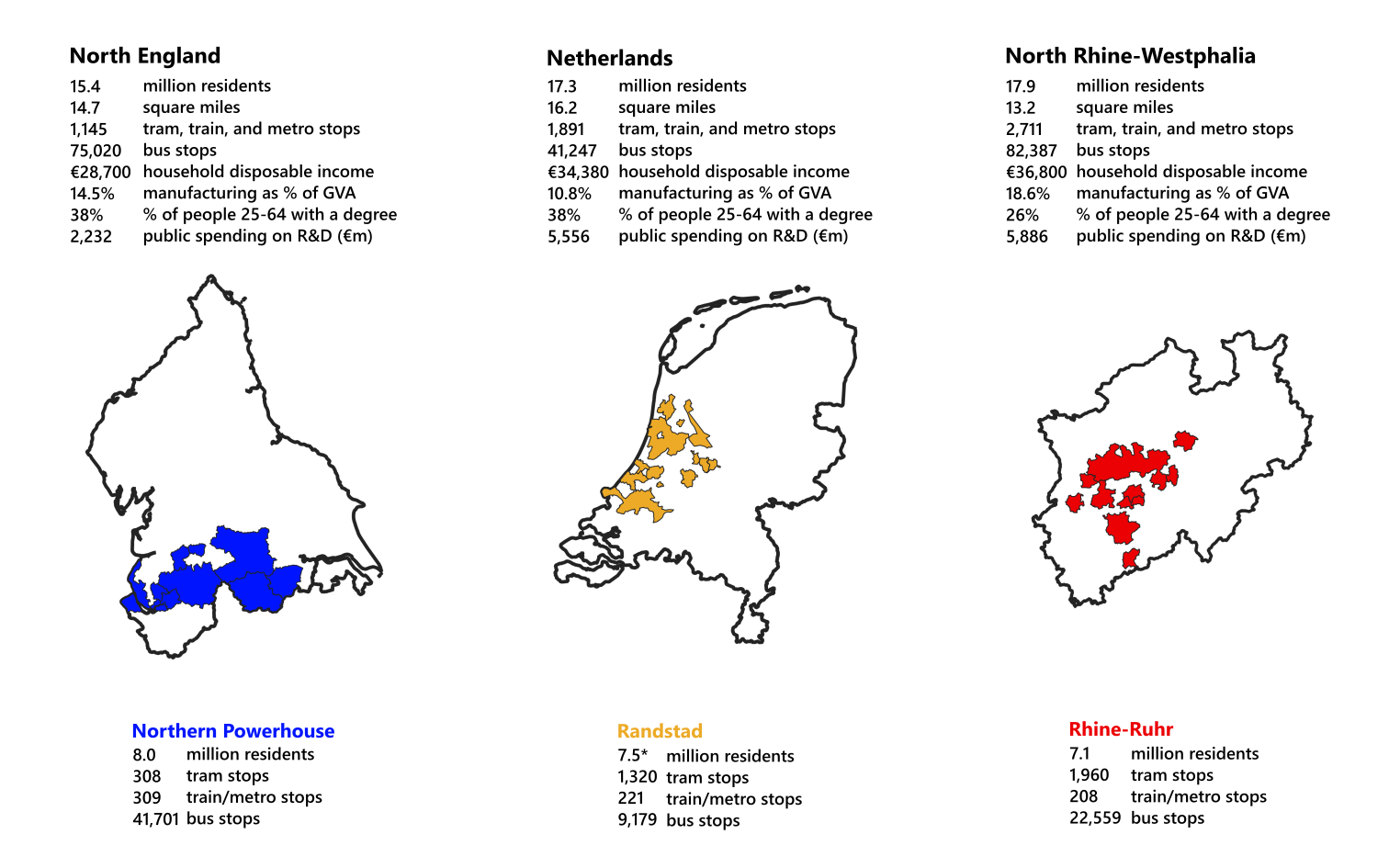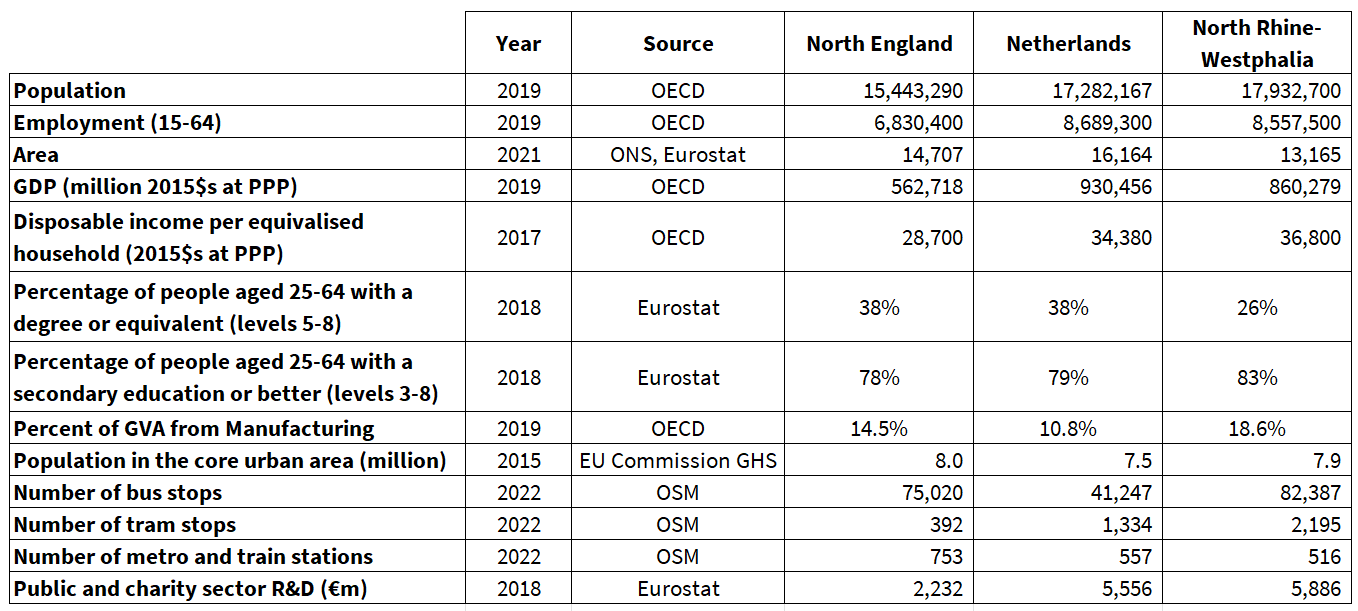
Further North: North England vs. North Rhine-Westphalia.
, .
Nine months ago I wrote a piece comparing the economy, the cities, and the people of North England and The Netherlands. I also compared their core urban regions showing that the two had almost identical population and density.
I suggested that North England had a clear role model to emulate and that doing so would lead to rapid economic growth, greater prosperity, and better lives for our people.
There was lots of positive feedback, quite a lot of negative feedback, and some unexpected bullying.
Probably the most frequent bit of negative feedback was that the Netherlands wasn't a fair comparison. It contains a national capital, its history is importantly less industrial, its geography is much better suited for prosperity, its people are culturally more driven to succeed, and much more. Thankfully there were no responses quite as blunt as published suggestions that North England is poor because we have worse genes and lower IQs.
The Ruhr.
I remain unconvinced by most of those pushbacks, but I couldn't convince most detractors. So I decided to pick another place like North England to compare it to.
My mind was drawn to the Ruhr following Simon Cooke's 2019 piece for Unherd, "let’s turn off the Northern Powerhouse". In that piece he urges us to abandon our ambitions for things like a fast train line, a tram system, and a TV channel and look to the Ruhr, not London, for inspiration. In the Ruhr he argued we might find a less urban vision of a prosperous future, more suited to our history, density, and situation.
I know very little about the Ruhr and its region, North Rhine-Westphalia. I've watched Dambusters, I once flew back from a friend's wedding in Greece via Düsseldorf, I know that Dortmund is the twin city of Leeds and home to an enormous football stadium. And that's about it.
In the absence of experience I looked for data.
The first thing I did was to improve my population around a point tool to count bus stops, tram stops, and metro/train stops in addition to people. It's not perfect, but it's pretty good. So I compared Leeds and Dortmund.

This has given some interesting results. North England has a lot of bus stops. I've written before about how Britain has too many buses so perhaps that's not a surprise. Also not a surprise is that Leeds has no tram stops, compared to 204 in Dortmund spread over 8 lines (stops are counted in each direction and some S-bahn stops are miscounted as tram stops before you explain that that's wrong).
But I didn't want to just compare Leeds and Dortmund, I wanted to compare North England with the Ruhr and its region, North Rhine-Westphalia.
North Rhine-Westphalia.
So I got together the data and some maps to make sense of it. The map below shows how similar in size and population the three regions and their three core urban regions are. The data shows that the economies are far less similar.

Or if you'd prefer a table, I made one of those too.

So what?
North England and North Rhine-Westphalia have many similarities, possibly even more than the Netherlands and North England. Both are quite high density regions with a high density urban core of about 8 million people and a history of heavy industry. But their current economic situation is very different.
Both GDP per person and household incomes in North Rhine-Westphalia are about 30% higher than in North England, a similar gap to what we see between the Netherlands and North England. Could North England achieve the same by abandoning plans for the fast train line, a tram system, and a TV channel as suggested by Cooke? Perhaps. But that doesn't seem to be how the Germans did it.
Cologne, in North Rhine-Westphalia is home to RTL, one of Germany's major television channels. To reach it from Dortmund at the East of the Ruhr agglomeration, you can take a fast electric train. Or if you would prefer to reach it via the West of the Ruhr agglomeration you can take a fast electric train from Duisburg. The journey between all three cities is covered by a dense network of suburban rail and tramways, regulated and managed by a single regional public body of the agglomeration, the Verkehrsverbund Rhein-Ruhr.
Far from a reason to cut back on transport investment and hopes of attracting TV channels, the Ruhr's success further convinces me that this is exactly the approach that North England should be taking. Not to become like London, I have no interest in that, but to become more like the Rhine-Ruhr and more like the Netherlands while remaining itself.
What the North is missing is the transport infrastructure in its urban core to operate as an agglomeration. North England would need three times as many tram stops to rival the Netherlands by that measure, and six times as many to rival the Rhine-Ruhr agglomeration.
The data suggests that North England also lacks the level of state investment in research and development that would attract and retain skilled people and help generate the new ideas and new businesses that create economic growth.
Or maybe I've got it all wrong. I'm sure that a lot of you will tell me that. And unlike in my piece about the Netherlands, I'm unlikely to have a good idea about whether you're right or wrong. Because I've never been to Dortmund, or Cologne, or Duisburg, or anywhere in between. Maybe one day I will. I'll take a tram. We don't have any in Leeds.